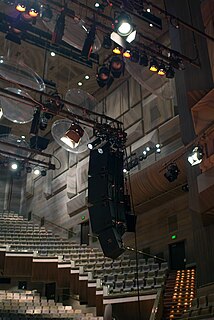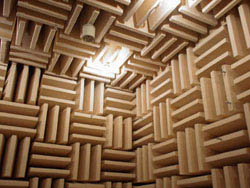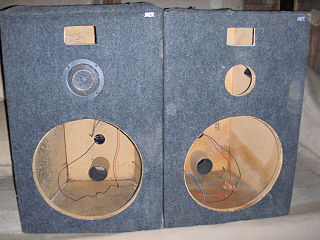
Noise pollution, also known as environmental noise or sound pollution, is the propagation of noise with ranging impacts on the activity of human or animal life, most of them harmful to a degree. The source of outdoor noise worldwide is mainly caused by machines, transport, and propagation systems. Poor urban planning may give rise to noise disintegration or pollution, side-by-side industrial and residential buildings can result in noise pollution in the residential areas. Some of the main sources of noise in residential areas include loud music, transportation, lawn care maintenance, construction, electrical generators, explosions, and people.
Reverberation, in psychoacoustics and acoustics, is a persistence of sound after the sound is produced. A reverberation, or reverb, is created when a sound or signal is reflected causing numerous reflections to build up and then decay as the sound is absorbed by the surfaces of objects in the space – which could include furniture, people, and air. This is most noticeable when the sound source stops but the reflections continue, their amplitude decreasing, until zero is reached.

A recording studio is a specialized facility for sound recording, mixing, and audio production of instrumental or vocal musical performances, spoken words, and other sounds. They range in size from a small in-home project studio large enough to record a single singer-guitarist, to a large building with space for a full orchestra of 100 or more musicians. Ideally both the recording and monitoring spaces are specially designed by an acoustician or audio engineer to achieve optimum acoustic properties.

Acoustical engineering is the branch of engineering dealing with sound and vibration. It includes the application of acoustics, the science of sound and vibration, in technology. Acoustical engineers are typically concerned with the design, analysis and control of sound.

Soundproofing is any means of reducing the sound pressure with respect to a specified sound source and receptor. There are several basic approaches to reducing sound: increasing the distance between source and receiver, using noise barriers to reflect or absorb the energy of the sound waves, using damping structures such as sound baffles, or using active antinoise sound generators.

Architectural acoustics is the science and engineering of achieving a good sound within a building and is a branch of acoustical engineering. The first application of modern scientific methods to architectural acoustics was carried out by Wallace Sabine in the Fogg Museum lecture room who then applied his new found knowledge to the design of Symphony Hall, Boston.
Acoustic absorption refers to the process by which a material, structure, or object takes in sound energy when sound waves are encountered, as opposed to reflecting the energy. Part of the absorbed energy is transformed into heat and part is transmitted through the absorbing body. The energy transformed into heat is said to have been 'lost'.

Noise control or noise mitigation is a set of strategies to reduce noise pollution or to reduce the impact of that noise, whether outdoors or indoors.
Acoustic foam is an open celled foam used for acoustic treatment. It attenuates airbone sound waves, reducing their amplitude, for the purposes of noise reduction or noise control. The energy is dissipated as heat. Acoustic foam can be made in several different colors, sizes and thickness.

A noise barrier is an exterior structure designed to protect inhabitants of sensitive land use areas from noise pollution. Noise barriers are the most effective method of mitigating roadway, railway, and industrial noise sources – other than cessation of the source activity or use of source controls.

A loudspeaker enclosure or loudspeaker cabinet is an enclosure in which speaker drivers and associated electronic hardware, such as crossover circuits and, in some cases, power amplifiers, are mounted. Enclosures may range in design from simple, homemade DIY rectangular particleboard boxes to very complex, expensive computer-designed hi-fi cabinets that incorporate composite materials, internal baffles, horns, bass reflex ports and acoustic insulation. Loudspeaker enclosures range in size from small "bookshelf" speaker cabinets with 4" woofers and small tweeters designed for listening to music with a hi-fi system in a private home to huge, heavy subwoofer enclosures with multiple 18" or even 21" speakers in huge enclosures which are designed for use in stadium concert sound reinforcement systems for rock music concerts.

Roadway noise is the collective sound energy emanating from motor vehicles. It consists chiefly of road surface, tire, engine/transmission, aerodynamic, and braking elements. Noise of rolling tires driving on pavement is found to be the biggest contributor of highway noise which increases with higher vehicle speeds.

A line source, as opposed to a point source, area source, or volume source, is a source of air, noise, water contamination or electromagnetic radiation that emanates from a linear (one-dimensional) geometry. The most prominent linear sources are roadway air pollution, aircraft air emissions, roadway noise, certain types of water pollution sources that emanate over a range of river extent rather than from a discrete point, elongated light tubes, certain dose models in medical physics and electromagnetic antennas. While point sources of pollution were studied since the late nineteenth century, linear sources did not receive much attention from scientists until the late 1960s, when environmental regulations for highways and airports began to emerge. At the same time, computers with the processing power to accommodate the data processing needs of the computer models required to tackle these one-dimensional sources became more available.

Diffusion, in architectural acoustics, is the spreading of sound energy evenly in a given environment. A perfectly diffusive sound space is one in which the reverberation time is the same at any listening position. Most interior spaces are non-diffusive; the reverberation time is considerably different around the room. At low frequencies they suffer from prominent resonances called room modes.

An acoustic transmission line is the use of a long duct, which acts as an acoustic waveguide and is used to produce or transmit sound in an undistorted manner. Technically it is the acoustic analog of the electrical transmission line, typically conceived as a rigid-walled duct or tube, that is long and thin relative to the wavelength of sound present in it.
Masking Sound is the addition of generated sound into an environment to mask unwanted sound. It relies on auditory masking. Masking sound is not an active noise control. Masking sound reduces or eliminates perception of sound. The technology is promoted as a widespread application to an entire area to improve the acoustical satisfaction, by improving the acoustical privacy of the space. This improves one's ability to focus and their productivity.
Noise, vibration, and harshness (NVH), also known as noise and vibration (N&V), is the study and modification of the noise and vibration characteristics of vehicles, particularly cars and trucks. While noise and vibration can be readily measured, harshness is a subjective quality, and is measured either via "jury" evaluations, or with analytical tools that can provide results reflecting human subjective impressions. These latter tools belong to the field known as "psychoacoustics."

A drum screen, sometimes referred to as a drum shield or acoustic shield, is a tool used by audio engineers to avoid the sound control problems caused when louder instruments overwhelm quieter instruments and vocals on stage. It is a transparent acoustic panel or system of panels that are used around drums, percussion instruments, and possibly other loud musical instruments in order to acoustically separate unusually loud instruments from other musical instruments and vocalists that may be close by.
Acoustic quieting is the process of making machinery quieter by damping vibrations to prevent them from reaching the observer. Machinery vibrates, causing sound waves in air, hydroacoustic waves in water, and mechanical stresses in solid matter. Quieting is achieved by absorbing the vibrational energy or minimizing the source of the vibration. It may also be redirected away from the observer.
Acoustic plaster is plaster which contains fibres or aggregate so that it absorbs sound. Early plasters contained asbestos, but newer ones consist of a base layer of absorptive substrate panels, which are typically mineral wool, or a non-combustible inorganic blow-glass granulate. A first finishing layer is then applied on top of the substrate panels, and sometimes a second finishing layer is added for greater sound attenuation. Pre-made acoustic panels are more commonly used, but acoustic plaster provides a smooth and seamless appearance, and greater flexibility for readjustment. The drawback is the greater level of skill required in application. Proprietary types of acoustic plaster developed in the 1920s included Macoustic Plaster, Sabinite, Kalite, Wyodak, Old Newark and Sprayo-Flake produced by companies such as US Gypsum.













